

Ecology. Ecology is an interdisciplinary field that includes biology and Earth science.
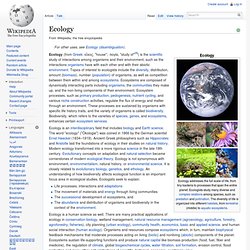
Food chain. A food web (or food cycle) depicts feeding connections (what-eats-what) in an ecological community and hence is also referred to as a consumer-resource system.
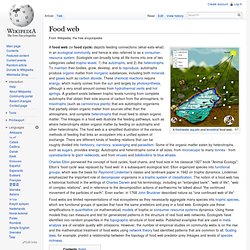
Ecologists can broadly lump all life forms into one of two categories called trophic levels: 1) the autotrophs, and 2) the heterotrophs. To maintain their bodies, grow, develop, and to reproduce, autotrophs produce organic matter from inorganic substances, including both minerals and gases such as carbon dioxide. These chemical reactions require energy, which mainly comes from the sun and largely by photosynthesis, although a very small amount comes from hydrothermal vents and hot springs. Ecology. Ecology is an interdisciplinary field that includes biology and Earth science.
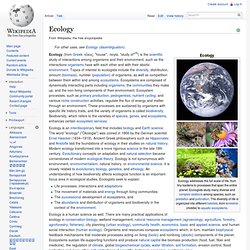
The word "ecology" ("Ökologie") was coined in 1866 by the German scientist Ernst Haeckel (1834–1919). Ancient Greek philosophers such as Hippocrates and Aristotle laid the foundations of ecology in their studies on natural history. Modern ecology transformed into a more rigorous science in the late 19th century. Evolutionary concepts on adaptation and natural selection became cornerstones of modern ecological theory. Ecology is not synonymous with environment, environmentalism, natural history, or environmental science. Ecology is a human science as well. Ecosystem services. Humankind benefits in a multitude of ways from ecosystems.

Collectively, these benefits are known as ecosystem services. Biome. Different biomes Ecoregions are grouped into both biomes and ecozones.

A fundamental classification of biomes are: Terrestrial (land) biomesAquatic biomes (including freshwater biomes and marine biomes) Biomes are often known in English by local names. For example, a temperate grassland or shrubland biome is known commonly as steppe in central Asia, prairie in North America, and pampas in South America. Sometimes an entire biome may be targeted for protection, especially under an individual nation's biodiversity action plan. Climate is a major factor determining the distribution of terrestrial biomes. Tropics. World map with the intertropical zone highlighted in red Tropical climate zones of the Earth where all twelve months have mean temperatures above 18 °C (64 °F).

The tropics is a region of the Earth surrounding the Equator. It is limited in latitude by the Tropic of Cancer in the northern hemisphere at 23° 26′ 16″ (or 23.4378°) N and the Tropic of Capricorn in the southern hemisphere at 23° 26′ 16″ (or 23.4378°) S; these latitudes correspond to the axial tilt of the Earth. Eugene Odum. Eugene Pleasants Odum (September 17, 1913 – August 10, 2002) was an American biologist at the University of Georgia known for his pioneering work on ecosystem ecology.
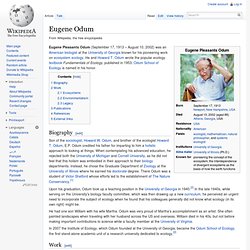
He and Howard T. Tropical rainforest. A tropical rainforest is an ecosystem type that occurs roughly within the latitudes 28 degrees north or south of the equator (in the equatorial zone between the Tropic of Cancer and Tropic of Capricorn).
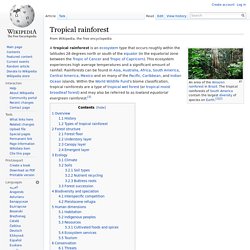
This ecosystem experiences high average temperatures and a significant amount of rainfall. Rainforests can be found in Asia, Australia, Africa, South America, Central America, Mexico and on many of the Pacific, Caribbean, and Indian Ocean islands. Within the World Wildlife Fund's biome classification, tropical rainforests are a type of tropical wet forest (or tropical moist broadleaf forest) and may also be referred to as lowland equatorial evergreen rainforest.[3] Overview[edit] Tropical rainforests can be characterized in two words: hot and wet. Tropical rainforests are among the most threatened ecosystems globally due to large-scale fragmentation as a result of human activity.
History[edit] Community. Since the advent of the Internet, the concept of community has less geographical limitation, as people can now gather virtually in an online community and share common interests regardless of physical location.

Prior to the internet, virtual communities (like social or academic organizations) were far more limited by the constraints of available communication and transportation technologies. The word "community" is derived from the Old French communité which is derived from the Latin communitas (com, "with/together" + munus, "gift"), a broad term for fellowship or organized society.[1] Some examples of community service are to help in church, tutoring, hospitals, etc. Perspectives from various disciplines[edit] Sociology[edit] Ecosystem. History and development The term "ecosystem" was introduced by Arthur Roy Clapham in early 1930s and became more widely known via the works of Arthur Tansley, a British ecologist.
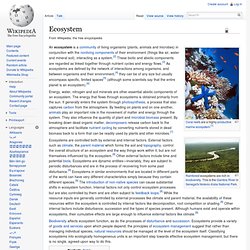
[fn 1][10] Tansley devised the concept to draw attention to the importance of transfers of materials between organisms and their environment.[11] He later refined the term, describing it as "The whole system, ... including not only the organism-complex, but also the whole complex of physical factors forming what we call the environment".[12] Tansley regarded ecosystems not simply as natural units, but as mental isolates.[12] Tansley later[13] defined the spatial extent of ecosystems using the term ecotope. G. Ecosystem processes Ecosystems are controlled both by external and internal factors. Unlike external factors, internal factors in ecosystems not only control ecosystem processes, but are also controlled by them.
Primary production Energy flow Left: Energy flow diagram of a frog. Decomposition Nutrient cycling.